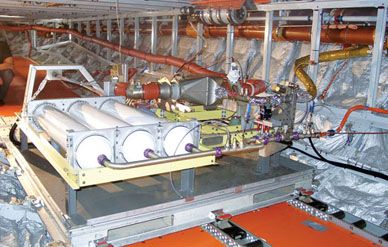Safer Fuel Tanks
Once airliners implement this pending FAA rule, a spark will no longer become a flame
WHEN TWA FLIGHT 800 EXPLODED OFF THE COAST of Long Island in 1996, many people suspected a terrorist bomb or missile. Federal investigators, however, focused on a more mundane source for the catastrophe: the Boeing 747’s center fuel tank.
Although the exact cause remains unknown, in 1997 the National Transportation Safety Board concluded that an electrical spark ignited a mixture of fuel vapor and air in the tank, setting off an explosion that destroyed the airliner and killed all 230 people on board.
In the years since, the Federal Aviation Administration has addressed half of the explosive equation—sources of sparks or other ignition hazards—by requiring airlines to provide better insulation, move wiring, inspect fuel pumps, and take other actions.
Later this year, the FAA plans to order reductions in the flammability of gases that float in the void above Jet A fuel in airliner tanks. Airlines and manufacturers will be able to meet the requirement by using systems based on a prototype developed by the FAA—an onboard inert-gas generation system (OBIGGS), which replaces much of the air in a fuel tank with nitrogen, a gas that does not support combustion. The technology “will virtually eliminate the possibility of future fuel tank explosions,” FAA Administrator Marion Blakey said in February when announcing the agency’s plans to recommend that 3,800 Boeing and Airbus airliners be fitted with inerting technology.
The military has used inerting systems for decades to reduce the chance of fire resulting from bullet or shrapnel impacts. The F-16, for example, injects Halon 1301 gas, a common fire suppression chemical, into its tanks, while the giant C-5 uses liquid nitrogen, which is denser than its gaseous form (and thus requires less storage space) and which can easily be warmed to expand into a gas. But these systems are expensive and heavy, and require extensive ground support, making them impractical for most commercial aircraft.
Engineers have made a breakthrough in the last couple of years by “challenging assumptions,” says John Hickey, director of the FAA’s aircraft certification service. “We thought you had to get the oxygen down to about nine percent, which is what the military uses. But we looked at 12 percent, and the tests said that it works.”
With a lower percentage of nitrogen required, a team led by FAA engineer Ivor Thomas was able to develop an OBIGGS prototype that weighs less than 200 pounds—about one-tenth what a typical military system weighs—and requires no compressors or other moving parts.
The system uses “a small amount” of air from the engines, Hickey says. The air flows through a 1.5-inch-diameter stainless steel pipe into a heat exchanger, which gulps air from outside the aircraft to cool the bleed air from about 350 degrees Fahrenheit to 180 degrees, the temperature at which the system separates nitrogen and oxygen most efficiently.
The cooled air passes through a filter that removes all but the tiniest particles of dirt and oil, then enters the heart of the system, the air separation module. The ASM consists of three parallel aluminum tubes; each is about 40 inches long and eight inches in diameter. The tubes are filled with bundled rows of permeable fibers, each fiber about the width of a human hair. “It looks a lot like a rope,” Thomas says of the bundles, with “millions” of individual fibers lined up in each tube.
The pressurized air that enters the ASM tubes consists of 78 percent nitrogen, 21 percent oxygen, and one percent trace elements—the same distribution as the air we breathe. As air enters the hollow interior of each fiber, oxygen and trace gases (and a small amount of nitrogen) permeate through the fiber walls and are vented and dumped overboard. As a result, the air exiting the far end of the fiber—and ultimately the ASM—consists of about 99.9 percent nitrogen.
Because aircraft fuel tanks are vented to allow for equalization of pressure at different altitudes, the nitrogen must be constantly fed into the tanks to displace the outside air that freely enters. Pressure valves regulate the flow so that the fuel tank
isn’t over-filled, and FAA ground tests of the prototype showed that the nitrogen is quickly distributed throughout the tank, so no fans are needed to circulate the gas. The system operates in two modes: low-flow and high-flow. When the airplane has taken off, instruments signal OBIGGS, and the system enters the low-flow mode. OBIGGS remains in that mode through climb and cruise. Since air pressure is much lower at cruising altitudes, the system can displace all but two or three percent of the fuel tank’s oxygen.
Conversely, during descent, air pressure rises, so more outside air flows into the tank, increasing the oxygen content. To compensate, OBIGGS goes into high-flow mode, pumping in additional nitrogen at a faster rate. Even so, the concentration of oxygen jumps from a few percent at cruising altitude to between nine and 12 percent at landing.
Airlines and manufacturers are not required to adopt the FAA prototype, Hickey notes. Boeing recently announced it will use its own system, which is based on the FAA prototype, and has committed to deploying it on the new 7E7. According to Hickey, FAA regulations probably will require installation of some fuel-inerting technology on all large jets in the U.S. fleet within five to seven years, at which point—in FAA’s Blakey’s words—“we can close the door on fuel tank explosions.”
